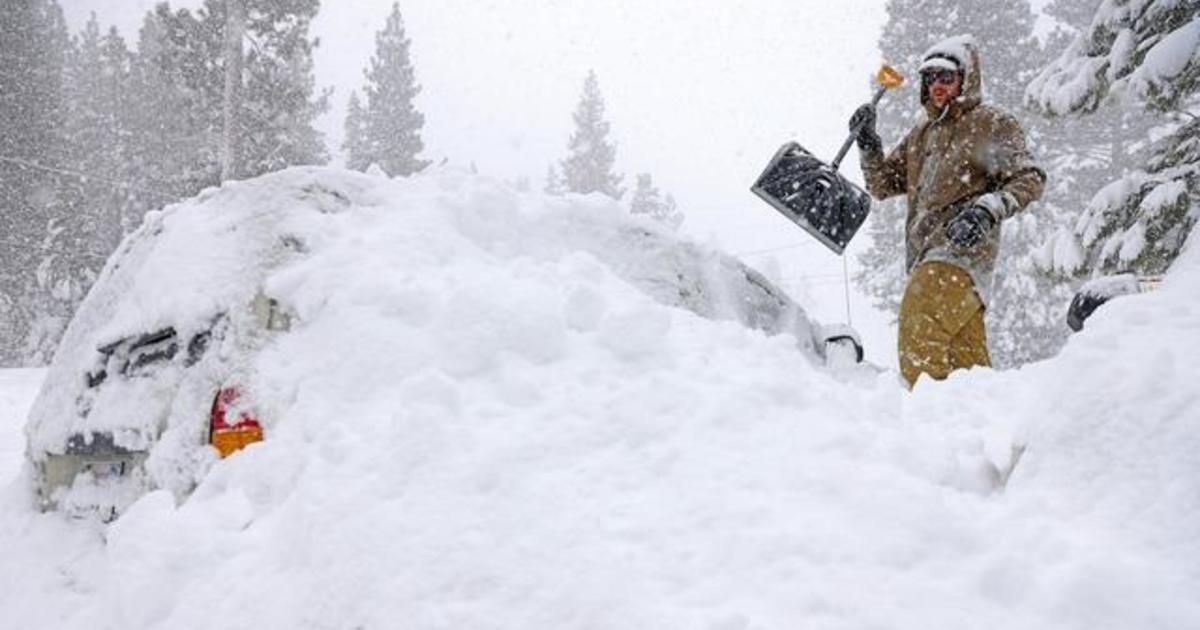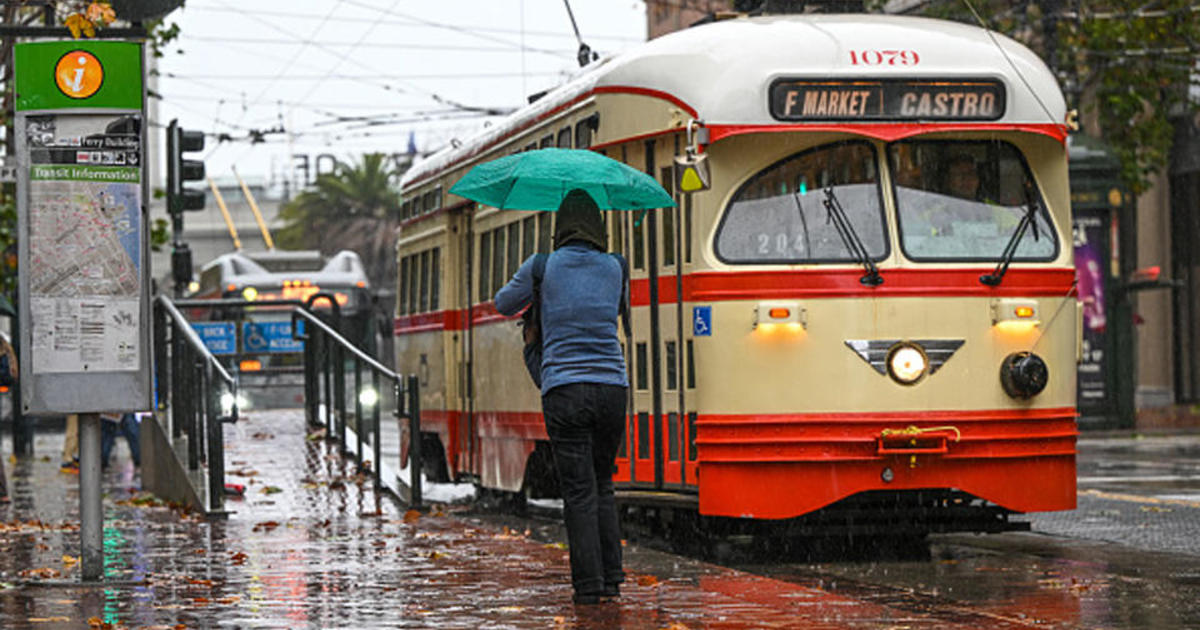Flood watch issued for Tahoe, Yosemite National Park; Soaring temperatures accelerating snow melt
YOSEMITE NATIONAL PARK -- The 'big melt' of the massive snowpack piled up across the Sierra range over the winter months has begun as a heat wave grips the region with temperatures forecast to reach near record highs later in the week.
With 700 to 800 inches of snow having accumulated across the range during a winter filled with atmospheric rivers, forecasters and water officials are now casing wary eyes at rapidly rising water levels in rivers and creeks.
"The big melt is now here," said weather expert Dr. Daniel Swain. "Right now it is looking like this week is going to an exclamation point on this melting process."
The National Weather Service has issued flood warnings and watches covering hundreds of miles of the High Sierra.
"Increasing temperatures with near record, or record breaking afternoon highs and warm morning lows will expedite snowmelt across the Sierra through the upcoming weekend," according to the weather service's Reno office. "Low elevation snow has recently taken a big hit so with temperatures expected to reach up to 20 degrees above average, we anticipate melting to begin rapidly eating away at the higher elevation snowpack as well."
Among the areas covered by the alerts are Lake Tahoe and Yosemite National Park, where the Merced River has already flowed over its banks at the Pohono Bridge. It is expected to peak Monday at about 2 or 3 feet above its flood stage
Much of the park will close from Friday night until at least Wednesday morning due to flood risk.
"Its a difficult decision and we understand that people are disappointed. But the health and safety of visitors is our primary concern," said park spokesman Scott Gediman. "We've had our biggest snowpack on record. We've needed it here in California. We're thankful for that. But it inevitably leads to snow melt."
Likewise, the Carson River near Gardnerville was also approaching flood stage.
Forecasters also warned residents to stay away from the churning waters. They are extremely cold and if you fall in you, you won't survive for long.
Now that epic snowpack is melting and filling waterways, neighbors in the Island District of Kings County have reactivated a crisis network to help each other prepare. The nearby city of Corcoran is adding to the top of a levee to try to keep water out.
Across the region nerves are on edge.
Ron Caetano lives in the Island District. He is packed and ready to go. His family photos and valuables are in the trailer and he's put food in carry totes. He moved the rabbits and chickens and their automatic feeders to higher ground.
He and his family and dogs could get out in less than an hour, they figure, should more heavy rain or hot weather melt so much mountain snow that gushing water overwhelms the rivers and channel that surround the rural Central California community.
"The water is coming this way," said Caetano, who started a Facebook group to help organize his neighbors. "I am preparing for the worst and praying for the best and that's all we can do."
After more than a dozen atmospheric rivers dumped record rain and epic snowfall on California, a reservoir that typically stores water upstream is expected to receive three times its capacity.
Caetano and his neighbors in the tree-lined Island District, home to a school, pistachio orchards and horse ranches about halfway between Los Angeles and San Francisco, could soon marooned by rising rivers or flooded out.
Water managers are concerned that the spring snowmelt in the Sierra Nevada will be so massive, the north fork of the Kings River won't be able to contain it and carry it toward the Pacific Ocean. Much of the water is being channeled into the river's south fork, which winds through the area to fill a vast basin.
More than a century ago, that basin was an enormous body of freshwater, the largest west of the Mississippi River, known as Tulare Lake, that would grow in winter as snowmelt streamed down from the mountains. But over time, settlers dammed and diverted waterways to irrigate crops, and the lake went dry. Now, Tulare Lake reappears only during the rainiest years, like this one, covering what is now a vast swath of farmland with water.
Today, paved roads vanish beneath the lake's lapping waves and utility poles and trees jut out above the water, vestiges of land-living put on hold. Fields that typically grow wheat, tomatoes, and other crops lie underneath.
David Merritt, general manager for the Kings River Conservation District, said the Pine Flat Reservoir about 50 miles (80 kilometers) upstream can hold up to 1 million acre feet of water, but is expected to receive more than 3 million acre feet this spring from the melting snow. Officials have been forced to increase the flow of water out of the reservoir to make space for more, Merritt said.
"Once we're at capacity, now you're putting a lot of stress on those conveyance channels," Merritt said. "It's a very fast moving stream and it's very deep right now."
Island District residents have revived a decades-old network of neighbors for the first time since 1983 to assist each other in the event of a crisis. The last time the Island Property Protection Association activated, there was no such thing as text messages or even emails to quickly spread the word, said Tony Oliveira, a former county supervisor and the network's administrator.
In a week, more than 200 people volunteered to help neighbors through the network, and the group's website received more than 4,000 hits.
"It's going to be four months of holding our breath," Oliveira said.
The winter rains were welcomed by California's parched cities and desperate growers, who have been grappling with intense drought for the past several years. The state has long tended toward wet and dry periods, but scientists at University of California, San Diego's Scripps Institution of Oceanography have said they expect climate change will lead to drier dry years and wetter wet years.
What will determine how communities fare now is how quickly the weather heats up. If temperatures remain cool, snow will melt slowly, with water gradually flowing from the mountains. But a hot spell could send massive amounts of water churning through rivers that could potentially overflow, officials said. A beaver or a squirrel that tears a hole in a levee could also bring trouble.
It isn't the first time Kings County, home to 150,000 people in the fertile San Joaquin Valley, has faced these challenges.
Many long-time residents recall when Tulare Lake reappeared 40 years ago. Officials believe crops will remain under water much longer this time due to the massive snowpack, said Dusty Ference, executive director of the Kings County Farm Bureau. To date, more than 60,000 acres of farmland have flooded, he said.
It also returned on a smaller scale in 1997, said Nicholas Pinter, associate director of the University of California, Davis Center for Watershed Sciences. He said the lake has always fluctuated in size due to California's highly-variable water cycle, and farmers have long known there would be periods like this.
"It has been an engineering problem all along," he said. "This is a bathtub with no drain."
Near the lake, the city of Corcoran, which is home to 22,000 people including 8,000 state prisoners, began emergency construction to raise a levee that protects the community. The water behind the levee is already at 178 feet (54 meters), just 10 feet (3 meters) below the top. Officials want to raise the levee another 3.5 feet (1 meter), city officials said.
"If that water rises above that amount, we will have water coming into our city and we will be in a critical situation," said Greg Gatzka, Corcoran's city manager.
In the Island District, residents don't have a levee to protect them. They snap photos of wooden sticks placed near waterways to gauge water levels and banks and post them online to keep others informed. They're helping place sandbags on elderly neighbors' property and paying close attention to reports from water and county officials, and from each other.
Oliveira, whose family has lived in the area for generations, said he remembers moving cattle and horses when the rains came in 1983, and will do the same this time, if necessary.
"We're farmers. We have bulldozers and backhoes, we have trailers. We can bring things to bear sometimes faster than the public agencies can," Oliveira said. "The people who live in the Island are just kind of those neighbors taking care of neighbors."



